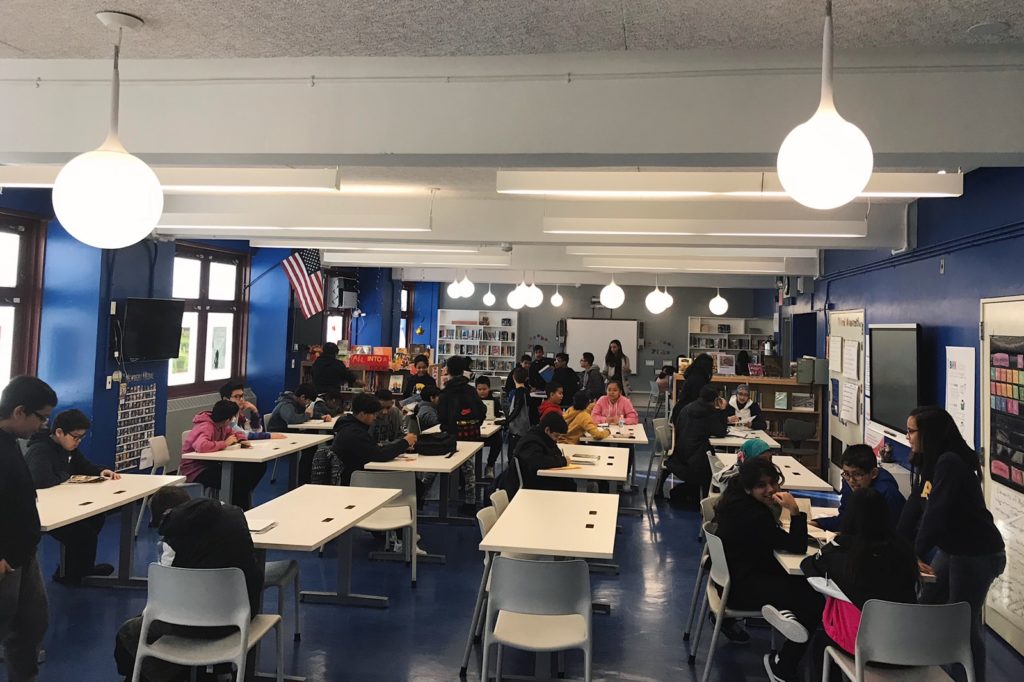When COVID-19 suddenly closed all New York City schools, school librarians mobilized to provide access to critical online learning resources. Following decades of drastic cuts to the numbers of trained librarians, their role became vital to all schools’ survival.

Photo credit: Michelle Brier
When the state ordered all New York City schools to shut their doors in mid-March to ward off the coronavirus, school librarians across the city shored up their resources and went to work.
“I’m seeing us like a colony of ants that just sort of assembled,” said Ciro Scardina, a high school librarian in Brooklyn.
Librarians are not just providing online books during the crisis, but guiding educators through a complicated web of free online services, creating virtual after-school activities to provide a semblance of community, and sharing expertise in media literacy to help students navigate news about the virus. In some cases, they’re also stepping up as tech support.
Their valued role has only been amplified, yet for decades, New York City has been continually cutting library positions in violation of state law. The mandate requires that all secondary schools are staffed by a certified library media specialist for a block of the day proportional to student enrollment. According to an analysis of available data by School-Stories.org, there are only a few hundred librarians serving over 1.1 million students.
“Unfortunately, that mandate is ignored by many, many schools,” president of New York City School Librarians’ Association Arlene Laverde said. “There are so many schools that do not have library spaces, nor do they have school librarians. And they have done such a huge disservice to their students. It is really apparent right now.”
Challenging what they view as a toothless mandate, the United Federation of Teachers sued the city’s Department of Education in 2014, appealing to the state to enforce its own law. The commissioner at the time, John King Jr., dismissed the case, but wrote, “I am troubled by respondents’ admitted noncompliance with the regulation.”
“Basically, nothing has changed since 2014,” Joseph Colletti, a special representative for the UFT, said.
To recruit more librarians, the Department of Education’s library services division began offering professional learning opportunities and reduced-cost master’s degree programs, through partnerships with Syracuse University, Long Island University, and University of Albany. A master’s degree is a requirement to get certified; however, as of 2016, some districts accept alternative certifications that don’t require as many credit hours.
But ultimately principals get to decide whether or not their school can afford a librarian. It’s hard to quantify the benefit of a library program, and decades of test-score driven policies have led principals to push libraries to the back burner. Despite the department’s efforts, a lack of funds and a belief that media centers with additional technology are sufficient for librarian services are a couple reasons principals might not prioritize librarians.
The state does, however, provide $6.25 per pupil for buying books, but that does not include a librarian’s salary. And for small schools with enrollment under 300 students, some administrators find it challenging to justify hiring a full-time certified librarian, when the law only requires them working for two periods a day.
The outlook for school librarian funding is even bleaker in the face of Covid-19. Last month, Gov. Andrew Cuomo warned that the city’s education budget could be cut by 20 percent and Mayor De Blasio proposed a budget with $827 million in cost-saving decisions for education funds, Chalkbeat reported.
School librarian positions were already at the top of staff positions to be cut. “In some districts, all library positions will be cut; in others, only retiring staff will not be replaced,” said Debra Kachel, a national school librarian expert. “The impact of Covid-19 will likely dramatically increase that decline.”
The teacher’s union is similarly concerned. “Now that we are looking at billions of dollars in cuts to education in New York City…,” said Joseph Colletti. “Well, who knows?”
Exactly how many schools are missing out is a number the city’s Department of Education, researchers, and the state have been asking for years. Most recently, the teacher’s union, via the city’s education department, requested information about library staffing from every principal, but that information was due in March, after the coronavirus hit.
Meanwhile, a 2016 census of school librarians conducted by The New York Library Association reported just 13 percent of the city’s secondary schools had properly staffed libraries.
More recently, researchers at SUNY Albany, Dr. Joette Stefl-Mabry and Dr. Michael Radlick, analyzed 2018-2019 data from the state and found about 350 middle and high schools have a library space but only 160 of those schools have a certified part-time or full-time librarian.
However, these numbers do not count any classroom teacher acting as a librarian, of which there are many. With data from The Campus Librarian Network and a Department of Education self-reported survey, School-Stories.org found that there were approximately 350 individual librarians working in New York City, including teachers serving as librarians.
Past studies have found that teachers and students who collaborate with librarians enjoy benefits ranging from higher graduation rates to more effective teaching. However, emerging research from SUNY Albany is working towards examining the causal effect school librarians have on students’ academic achievement, advocating for stronger empirical scrutiny of current research.
The consensus thus far holds that librarians are trained to teach and empower students to ask what is true and what isn’t, to ask, how do I get myself the information I need and what questions do I need to be asking to find the material I need to read?
“Librarians teach the learning how to learn skills, the information skills,” Barbara Kay Stripling, a career librarian who now teaches at Syracuse University School of Information Studies, said.
“There is no time where those skills are more important than right now.”
